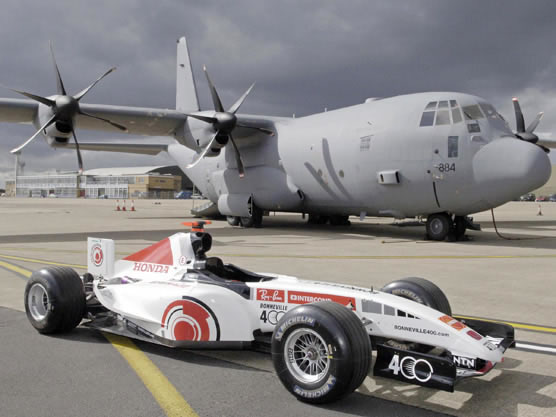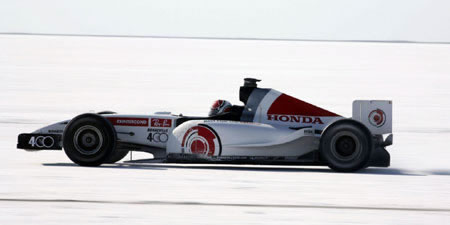Formula 1 Speed
In Formula 1, top speeds are in practice limited by the longest straight at the track and by the need to balance the car's aerodynamic configuration between high straight line speed when low downforce is needed, and high cornering speed with high downforce demands, to achieve the fastest lap time.
During the 2006 season, the top speeds of Formula 1 cars are a little over 300 km/h at high-downforce tracks such as Albert Park, Australia and Sepang, Malaysia. These speeds are down by some 10 km/h from the 2005 speeds, and 15 km/h from the 2004 speeds, due to the performance restrictions.
On low-downforce circuits greater top speeds are registered at Gilles-Villeneuve circuit (Canada) 325 km/h, at Indianapolis (USA) 335 km/h. For most of the year Monza's Villa Royal park, 25 kilometers from Milan, provides a picturesque route for joggers and cyclist. But buried deep within the woodland lies Formula 1's fastest challenge. The historic circuit is dubbed the 'cathedral of speed' and it holds the records for the highest speed - 371.7kph - recorded by an F1 car, the fastest ever lap, the quickest grand prix in history and the closest finish, with just a hundredth of a second separating the first two cars back in 1971. In the Italian Grand Prix 2004, Antônio Pizzonia of BMW WilliamsF1 team recorded a top speed of 369.9 kilometers per hour.
Newly-reconfigured Autodromo Hermanos Rodriguez in Mexico City replaced Monza as the temple of top speed in 2015, with the high altitudes of 2,220m above sea level, producing highest recorded season-high speeds, Pastor Maldonado's staggering 366.4 km/h (227.7 mph) through the speed trap on Sunday - significantly faster than the pre-V6 era. Second on the list was Sebastian Vettel with 366.2 km/h.
And then 2016 at new Baku (Azerbaijan) Formula 1 city track produced record top speeds at the end of the straight. Valtteri Bottas was officially clocked across the start/finish line as going at 366.1 km/h during qualifying in Baku, as the result of a slipstream he had got off Max Verstappen's Red Bull.
However, as braking zone for Turn 1 is far after the start/finish line, Williams' data showed that his car continued to accelerate after that reading and reached a peak of 378km/h shortly afterwards. This figure is in excess of speed trap figures from F1's other high-speed venues, Mexico and Monza. Baku's top speeds are more of a shock because of the tight and twisty nature of the city track once the cars have left the 2.1km long straight.
2018. on his final season with Ferrari, Kimi Raikkonen can certainly hold his head high, this time on Ferrari's home turf in Monza. At the time, it was Juan Pablo Montoya who held the record for the fastest lap in F1 history, but Raikkonen ended the Colombian's 14-year reign with a blistering lap of his own to secure pole with time of 1:19.119s. The Scandinavian was 406/1000 faster than the Colombian, which 14 years earlier did so with a V10 engine of more than 900 horsepower, similar power to that of the current hybrid V6 (combustion and electric). Räikkönen, in that run, on the straights loosely exceeded 300 km/h and reached the fastest lap average in the history of the Monza with 263,587 km/h.
(Edit: 2020. Levis Hamilton get pole position with fastest lap average in F1 history with time of 1:18.887, at 264.392 km/h, and Hamilton's 94th pole position.)
Away from the track, the BAR F1 Honda team used a modified BAR 007 car, which they claim complied with FIA Formula One regulations, to set an unofficial speed record of 413.205kmh, or 265.754mph on a one way straight line run on 6 November 2005 during a shakedown ahead of their Bonneville 400 record attempt. The car was optimized for top speed with only enough downforce to prevent it from leaving the ground. The car, badged as a Honda following their takeover of BAR at the end of 2005, set an FIA ratified record of 400 km/h on a one way run on 21 July 2006 at Bonneville Salt Flats. On this occasion the car did not fully meet FIA Formula One regulations, as it used a moveable aerodynamic rudder for stability control, breaching article 3.15 of the 2006 Formula One technical regulations which states that any specific part of the car influencing its aerodynamic performance must be rigidly secured.



Forward acceleration
The 2008 F1 cars have a power-to-weight ratio of around 1,250 hp (932 kW)/tone (0.9 kW/kg).
Theoretically this would allow the car to reach 100 km/h (62 mph) in less than 1 second. However the massive power cannot be converted to motion at low speeds due to traction loss, and the usual figure is 2 seconds to reach 100 km/h.
After about 130 km/h traction loss is minimal due to the combined effect of the car moving faster and the downforce, hence the car continues accelerating at a very high rate.
The figures are (for the 2007 Renault R27):
0 to 100 km/h (62 mph): 2.0 seconds
0 to 200 km/h (124 mph): 3.9 seconds
0 to 300 km/h (186 mph): 8.6 seconds
Figures may alter slightly depending on the aerodynamic setup.
The acceleration figure is usually 2.46 g (24.1 m /s) up to 200 km/h, which means the driver, is pushed back in the seat with 2.46 times his body weight.






